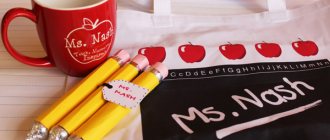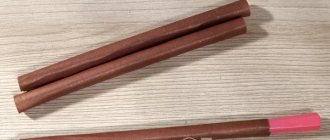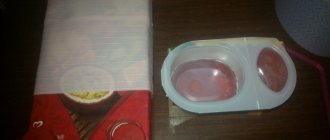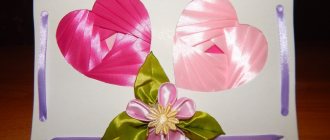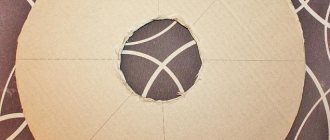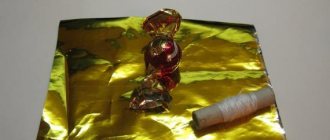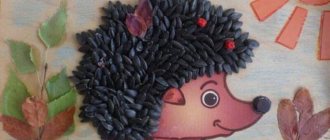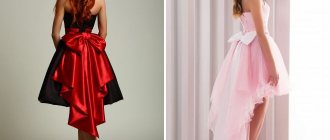How to sew a Cheburashka
The parts of the Cheburashka toy are cut out of synthetic fur in two colors - brown and white.
Patterns
Step by step process
1. From light (white) fur, cut out the toy’s muzzle, bib, ears (front side), and palms.
2. From brown fur, cut out the front and back sides of the body, the head (back of the head) and the front side, the upper parts of the foot, the lower parts of the foot (preferably from cloth), the headband for the ears, the ears (back side), and the hands.
3. A bib cut from light fur is sewn into the front part of the body. Baste both parts of the body and sew them with frequent oblique stitches over the edge, leaving unsewn places along the neck line and the end of the legs. Turn out the part.
4. Sew along the edge of the foot, connecting parts of cloth and fur, turn it through the hole in the upper part of the foot, stuff it with cotton wool and sew it to the ends of the legs. Stuff the body with cotton wool.
5. Sew the head: sew the muzzle piece into the hole left on the front side of the head. Baste and sew both parts of the head, turn them inside out and stuff them with cotton wool. Sew the head to the body along the neck line.
6. Sew the ears: insert the front sides of the ears, cut from light fur, into the ear headband, baste and sew.
Connect both parts of the ears, baste and sew along the edge, leaving room for turning out the parts. Turn the ears inside out and sew them to the head without stuffing.
7. Sew the palms into the front of the arms, then sew both parts of the arms, turn them inside out and sew them to the body.
8. Decorate the face - glue on the eyes, nose and mouth.
We felt Cheburashka from wool with our own hands
Do you love Soyuzmultfilm as much as I love it? 
I recently remembered: “A young crocodile of fifty years old wants to make friends.” Well, well, that means we’ll play with our crocodile friend, because “...you need to do a lot of good things to become a pioneer...”
Moreover, the wool for this master class has long been awaiting its release. To work, we will need several days of free time and:
To work, we will need several days of free time and:
- wool of the main color (in our case, carded) and a little wool of a light shade (we have combed tape); — needles for felting No. 36 forward and No. 40 reverse; - sponge for felting flat parts; - slicker; — glue “Moment Crystal”; - scissors; - polymer clay (I have doll fimo, black and white fimo, brown ezki); — tools for modeling (if necessary); - a surface for modeling, preferably one on which you can bake (I have ordinary glass); — acrylic paints (black, red, white); - brushes; — glossy and matte varnish for polymer clay; — watercolor pencils (dark brown, orange) or dry pastels; — life-size sketch of the work; - hot tea (in our case, green with lemon) 
Let's get started, brevity is not my strong point, but I'll try 
From polymer clay of the desired color (I mixed white doll polymer from Fimo with a small piece of brown plastic to get a color similar in shade to light wool, not forgetting to take into account when kneading that this plastic darkens a shade after baking), we form a semi-volume cake. It’s convenient for me to work on transparent glass, you can put it on a sketch at any time and check the shape and size of the part being sculpted; trust your eye, of course, but double-check it a thousand times . When you have brought the cake to completely coincide with the shape of the drawing, we press it a little in the middle with your finger.
It’s convenient for me to work on transparent glass, you can put it on a sketch at any time and check the shape and size of the part being sculpted; trust your eye, of course, but double-check it a thousand times . When you have brought the cake to completely coincide with the shape of the drawing, we press it a little in the middle with your finger.
After this, using pinching movements we form the top of the nose. We make two indentations in the place of the future eyes, and check them again with the sketch, correcting them if necessary.
We fill the eye sockets with two balls of white plastic, decorate the tip of the nose with a small triangle and the eyebrows with tiny cylinders made of brown polymer.
From black (or dark brown) polymer clay, sculpt tiny hands with a pointed base, bake the parts at the specified temperature for the required time.
From a small mass of wool we begin to form the head. The result should be a very dense (I don’t even know what to call it correctly) ellipsoid, or something, of irregular shape (which we do not forget to compare with a cheat sheet-sketch). In the second photo, I’m squeezing with effort what I got, and it finally doesn’t give way. Now you need to “tread” the area for the muzzle with a needle, it was convenient for me to do this right on the table on which the sketch lay, therefore, traces of my efforts will be slightly visible in further photographs 
We try it on, if everything matches, we rejoice and move on, if not, we modify it, and then we rejoice and move on. 
We felt the sausage-shaped body and roll it to the head; if the joint seems not strong enough, add a little wool to the joint and roll it.
Make a small semi-oval depression in the place of the breast (my Cheburashka should turn out to be looking to the side, so I deepen it not in the center, but closer to the side).
Fill the hole with light wool and felt it well.
From two identical pieces of wool, on a sponge, constantly turning over, felt a pair of ears, carefully felt the side parts, lightly pressing the parts with your fingers. Don’t forget about the cheat sheet, compare, Cheburashka’s ears, like his head, are irregular in shape.
Gently fluff the entire surface of the ears with a reverse needle, comb with a slicker and, if necessary, trim.
Place your ears in their proper place.
Now you can glue the muzzle - lubricate both parts with Moment Crystal glue, then press it well, and start making sausage legs from two identical tufts of wool.
Use an awl/knitting needle/the back of a brush to dig out a hole for the handles, and glue the parts as deeply as possible using a small amount of glue. Fluff the details with a reverse needle, comb, trim.
It’s more convenient, of course, to first lay down the legs, and at the very end the handles, but if you, like me, are not looking for easy ways, then you can fix them now. As the classic said - “Don’t worry, Gen, let’s rest and redo it again ."
As the classic said - “Don’t worry, Gen, let’s rest and redo it again ."
Felt two small loose balls, form them into dense legs immediately on the body.
Check to see if it turned out like in the cartoon - “...I screwed up again!...”. Place it on a flat surface, the support area allows the toy to stand on its own, if Cheburashka falls, persuade him with a needle, falling down and flattening the base, he must agree 
Carefully process the entire carcass with a reverse needle. For a narrow circle of connoisseurs with refined taste, of course, you can leave it like that, but my average, delicate, vulnerable psyche wished for the continuation of the creative process, which means further makeup and haircut.
We draw the pupils with black acrylic paint, enliven the eye with highlights of white color, draw a red oval mouth, tint the face with watercolor pencils - first rub an orange pencil strongly over the entire surface, then, along the perimeter, at the junction with the fur, a dark brown one. We cover the eyes with glossy varnish in two layers, wait for it to dry, and cover the face with matte varnish for polymer clay.
Well, well, “We built and built and finally built. Hooray!"
I wish you creative success! And watch good old cartoons 
Please do not use the master class for commercial purposes, and when copying material, indicate the source and author.
Craft made from corrugated cardboard. Cheburashka using quilling technique
Master class on handicrafts (working with paper). Cheburashka made of corrugated cardboard
Author: Elena Borisovna Goryunova, teacher at MBDOU DS No. 358 “Cheburashka”, Chelyabinsk.
Description of work: I offer you a master class on making crafts from corrugated cardboard “Cheburashka”, this master class can be used when working with children 6-7 years old. The finished craft can be used as a decoration for a group, as a gift or participation in various competitions.
Cheburashka decorates a corner in our group.
Cheburashka from the back.
To make this craft you will need corrugated cardboard, cut into strips 50 cm * 1 cm (21 brown stripes and 11 yellow), 1 pair of eyes, 1 nose, 1 mouth, PVA glue.
To make the head, take 4 yellow stripes and 1 brown, glue them into one long strip (yellow + yellow + yellow + yellow + brown). Roll the resulting long strip into a tight disk, starting at the yellow end. Secure the end of the strip with glue so that the disk holds its shape. Then we take 5 brown strips and glue them into one long strip. Roll the resulting long strip into a tight disk. Secure the end of the strip with glue. We give the blanks a dome shape (use your thumbs to carefully push out the layers from below, move from the edge of the part to the center), coat the inside of the domes with glue.
This is what the head blanks look like from the front side.
To make the body, take 3 yellow stripes and 1 brown, glue them into one long strip (yellow + yellow + yellow + brown). Roll the resulting long strip into a tight disk, starting at the yellow end. Secure the end of the strip with glue so that the disk holds its shape. Then we take 4 brown strips and glue them into one long strip. Roll the resulting long strip into a tight disk. Secure the end of the strip with glue. We give the blanks a dome shape (use your thumbs to carefully push out the layers from below, move from the edge of the part to the center), coat the inside of the domes with glue.
To make an ear, take 2 yellow strips and 1 brown, glue them into one long strip (yellow + yellow + brown). Roll the resulting long strip into a disk, starting from the yellow end. Secure the end of the strip with glue so that the disk holds its shape (we twist the disk loosely so that you can make a drop from the finished disk). Give the disc the shape of a drop (pinch the finished disc on one side, giving it a drop-shaped shape), coat the inside of the drop with glue.
We make 2 such parts.
To make a paw (leg), take 2 brown strips and glue them into one long strip. Roll the resulting long strip into a disk. Secure the end of the strip with glue so that the disk holds its shape (we twist the disk loosely so that you can make a drop from the finished disk). Then we give the disk the shape of a drop (pinch the finished disk on one side, giving it a drop-shaped shape), coat the inside of the drop with glue.
We make 2 such parts.
To make a paw (handle), take 1 brown strip. We make a spiral out of it (twist the disk, let it unwind to the desired size and glue the tip). Form a paw (handle) shape from the spiral.
We make 2 such parts.
Here are all the necessary preparations for Cheburashka.
We glue the prepared blanks for the head. Apply glue to the edges of the blanks and press them tightly together. Cover the joint area in a circle in one layer with a brown stripe. The result is a head.
We glue the prepared blanks for the body. Apply glue to the edges of the blanks and press them tightly together. Cover the joint area in a circle in one layer with a brown stripe. The result is a torso.
Here are all the necessary parts for Cheburashka.
Glue the head to the body.
We attach the remaining parts to the glued torso and head.
Glue the ears to the head, paws (legs) and paws (handles) to the body. We design the face. Cheburashka is ready!
Master class “Cheburashka” for Cheburashka’s Birthday at MAAM
Yulia Titova
Master class “Cheburashka” for Cheburashka’s Birthday at MAAM
Good afternoon, colleagues, MAAM friends and just random guests of my page.
Did you know that August 20 marks the birthday of our beloved childhood friend, the kindest and sweetest cartoon character CHEBURASHKA !
Probably all Soviet children had such a toy.
I also had Cheburashka. A funny toy given to me by my uncle. Chebukashka was big and not brown like in the cartoon, but made of green fabric and white ears with artificial white “hair,” cute black button eyes and a button mouth. I liked him very much.
On the Internet I saw that this hero has a birthday on August 20th.
Cheburashka was invented in 1966 by the writer Eduard Uspensky, who claims that the prototype was a defective children's toy - a half-hare, half-bear cub, which received the nickname "Cheburashka" in the family. According to Uspensky’s text, the main character was named Cheburashka because, having survived an uncomfortable journey in a box of oranges, he constantly strived to “cheburashka”, that is, to fall . (Internet source.)
Here are some more interesting facts
In the “Explanatory Dictionary of the Living Great Russian Language” by V. I. Dal, both the word “cheburakhnutsya” is described in the meaning of “fall”, “crash”, “stretch out”, and the word “Cheburashka”, which he defines in various dialects as “a saber of a burlatsky strap” , hanging on its tail,” or as “a stand-up roly-poly, a doll that, no matter how you throw it, gets to its feet on its own”[10]. According to Vasmer's etymological dictionary, “chebura khnut” is formed from the words chuburo k, chapuro k, chebura h - “a wooden ball at the end of a burlatsk tow”, of Turkic origin[11].
Another related word is “chebyrka,” a whip with a hair ball at the end.
The origin of the word “Cheburashka” in the meaning of “tumbler toy”, described by Dahl, is due to the fact that many fishermen made such toys from wooden balls, which were floats for fishing nets, and were also called “Cheburashka”
(Internet source Wikipedia)
Well, now the master class itself.
1) Application “Cheburashka” - the craft is quite simple and is suitable even for 2 ml. - middle group
To create this application we will need : 1 sheet of white cardboard (colored if desired) - this is the base; 1 sheet of brown paper, 1/2 sheet of yellow colored paper; PVA glue, brush, scissors.
1) On a sheet of brown paper we draw blanks for the applique: 3 circles of the same size, 4 small ovals and 1 large oval; on a sheet of yellow paper draw 3 identical circles, but slightly smaller
2) cut out our blanks and lay them out on a sheet of cardboard
3) glue all the parts.
Note that the “Ears” circles need to be glued under the “head” circle.
4) From a piece of white paper, cut out 2 small circles for eyes and glue them on.
5) after all the work has dried, draw the eyes and mouth
All is ready.
2) Craft from a Cheburashka sleeve
This craft is more complicated and can be used in work in the preparatory group both in class and in circle work on Art activities
To create this work we will need : 1 sheet of brown cardboard, 1 sheet of brown paper, 1/2 sheet of yellow colored paper; PVA glue, brush, scissors, cardboard toilet paper tube.
1) Take 1/2 a sheet of brown colored paper and carefully cover the sleeve. THIS WILL BE A BLANKET - The torso for Cheburashka.
We fold the edges of the paper inward and glue it. (For the lesson, it is better for the teacher to do this in advance, since children do not glue the paper evenly onto the sleeve);
2) While our workpiece is drying, we take a sheet of brown cardboard and draw details for Cheburashka.
2 circles of the same size - ears, 1 oval - head, 4 paws, and 2 small ovals - paws. We cut it all out.
Cut out 2 ovals from yellow paper, and cut out 2 circles for ears from brown paper.
3) Glue 2 legs together;
Then we glue brown paper circles onto the ears and glue the “Ears” circles to the head; yellow ovals on the head and body
Waiting for everything to dry
4) Glue the paws onto the body-sleeve on the sides and 2 ovals down - these are the paws
5) Glue 2 white circles onto the “Head - Ears” blank - these are the eyes
6) After everything has dried, draw the eyes and mouth with a felt-tip pen
7) glue the head onto the sleeve
All is ready
THANK YOU FOR YOUR ATTENTION!
Who invented Cheburashka?
09.01.2013
The Russian Language Center in Nuremberg hosted a literary festival “Who Invented Cheburashka?”, dedicated to the anniversary of Eduard Uspensky. There is no one among us adults who is not familiar with the work of this wonderful children's writer. But children born here in Germany also know and love the characters from Uspensky’s fairy tales - Crocodile Gena and Cheburashka, Shapoklyak and Kolobkov, Uncle Fyodor and his friends Sharik and Matroskin.
Answering the quiz questions, the guys surprised us with their knowledge of the writer’s funny work. The children were also told about Uspensky’s life and shown his books, which are in our library’s collections.
For the bright preparation of the holiday, I would like to express special gratitude to the Russian language teacher of the center, Inna Gorelik.
The holiday was accompanied by poems, colorful interactive illustrations, games and even small theatrical performances in which children attending the Russian Language Lyceum took part. Not without our favorite and familiar cartoons about Cheburashka and the plasticine crow. And when Cheburashka and Crocodile Gena themselves came to visit the children, the children happily sang their favorite song “Let them run clumsily” in Russian. And although this song was not written by Uspensky, it has firmly entered the consciousness and is the calling card of the heroes invented by the writer.
Speaking about one of his books, Eduard Uspensky noted: “If you constantly talk to children about the bad sides of life, then it will seem to them that the world in general is strange and bad. And I want to give them a feeling of a cheerful and good world!” We were convinced of this at our holiday - the writer’s work once again gave us a huge portion of kindness and warmth. And Eduard Uspensky was set as an example for all children, because he studies all his life.
At the age of 40, he began to master the computer. And he typed with only one finger, but now he types with all ten! At the age of 50, he began to learn English. And now he knows him so well that, together with the Dutch writer Els de Grun, he created the book “The Year of the Good Child.” He also began to learn to sing and became a publisher - he organized the Samovar publishing house. We wish Eduard Nikolaevich good health and, of course, new books.
Santa Claus also stopped by for the fun holiday, because Eduard Nikolaevich’s birthday was almost before the New Year and Christmas. All young participants of the holiday received gifts and the best New Year wishes.
Natella Yakimov, Russian Center in Nuremberg
Cheburashka
We will need: threads (preferably “Darnichanka”) of dark brown and light brown color, white cardboard, black and pink velvet paper, thin copper wire (used for beading) 20-25 cm, fluffy dark brown thread 50 cm , PVA glue, gypsy needle, sharp scissors.
Step 1
First we make the head of Cheburashka. We cut out two rings from cardboard with an outer radius of 2.5 cm and an inner radius of 1.7 cm. We wrap them with threads of two colors (dark brown and light brown, you can use black and brown, you can use brown and beige). We wrap more than half of these rings with dark brown thread, and the remaining smaller half with light brown thread.
Then we cut the threads along the outer edge, tie a knot in the center with a thread (it’s more practical to coat the knot with PVA glue, so it won’t loosen or come undone, let it dry), remove the cardboard rings, and fluff it up. We cut off the irregularities with scissors, giving the pompom a slightly oval shape.
Step 2
Now we make the body of Cheburashka. We cut out two rings from cardboard with an outer radius of 2 cm and an inner radius of 1 cm. We also wrap these rings with threads of two colors. The main color on these rings will be dark brown, and only a very small amount of light brown thread will be twisted.
Next, we make a pompom according to the pattern already known to us. Use scissors to trim the irregularities, giving the pompom an oval shape.
Step 3
We make two ears. We cut out four rings from cardboard with an outer radius of 2 cm and an inner radius of 1 cm. We connect the rings in pairs. We wrap these rings only with dark brown threads. Next, we make two pom-poms according to the scheme described above, only we do not wind very much thread (enough so that a small hole remains in the middle of the wrapped rings).
We trim the irregularities with scissors, giving the pompoms a round shape, since usually the pompoms turn out to be slightly oval.
Step 4
Let's make hands. We take thin copper wire (20-25 cm), which is used in beading. We wrap both ends of the wire with fluffy dark brown thread, leaving only about 4-5 cm of wire in the center without thread. Bend the wrapped ends of the wire in half, making hands out of them.
Step 5
Now we create Cheburashka himself. Cut out a 3x3 cm square from dark brown velvet paper. Glue a fluffy dark brown thread onto it with PVA glue, laying it out in the form of two legs. Glue the body on top of the square with the thread, placing it vertically. The light brown part of the pom pom should be at the front.
Next, we place the wire with the arms on top of the body (we place the unwrapped part of the wire in place of the neck so that after assembly the wire is inside and is not visible).
Then, placing the oval pom-pom head horizontally on the table, glue round dark brown pom-pom ears to it on both sides. Then the head and ears need to be fixed (squeezing them a little on both sides) between two objects for 15-20 minutes. After this, glue the head to the body: the light brown part of the pompom should be in front - this is Cheburashka’s face.
We cut out two circles with a diameter of 1 cm from white cardboard, then cut out two circles with a diameter of 0.5 cm from black velvet paper. Glue the black circles to the white circles - these are Cheburashka’s eyes, glue them to the light brown part of the head. Cut out a nose and two eyebrows from black velvet paper, and cut out a small mouth from pink velvet paper. Glue the eyebrows, nose and mouth onto the light brown part of the head. This is how we created Cheburashka's face.
(read more...) :: (to the beginning of the article)
Contents :: Search
Unfortunately, errors are periodically found in articles; they are corrected, articles are supplemented, developed, and new ones are prepared. Subscribe to the news to stay informed.
If something is unclear, be sure to ask! Ask a Question. Discussion of the article.
More articles
Postcard – Eastern mystery – do it yourself. An original gift. Eid... Making postcards - Eastern riddle - Description, step-by-step instructions...
Making pizza with nettles. Ingredients, composition. Cooking recipe... How to make pizza with nettles. Personal experience. Advice. Detailed step-by-step instructions...
Knitting. Stocking, garter stitch, closing the last row. Practice... Let's do a practical exercise - knit in stocking and garter stitch, close...
Knitting. Patterns – Rhombuses on the wrong side, checkers, checkers, chess... We knit patterns. Examples of patterns: diamonds on the reverse side, checkerboard pattern, checkerboard...
Knitting. Purl two together. Overflow. Openwork knitting... How to knit two together purl. Examples of drawings with such loops...
Long-term storage of cottage cheese. How to stock up for a long time. Freezing... How to keep cottage cheese fresh for a long time? Is it possible to freeze it? Can I...
Knitting. Fern leaves. Openwork tumblers. Drawings. Pattern patterns... How to knit the following patterns: Fern leaves. Openwork tumblers. Detailed and...
Duke (cherry-cherry hybrid, cherry). Growing Basics. Planting, ... How to plant and grow a hybrid of cherries and sweet cherries. How does it reproduce? Tips for...
Making a simple crocodile from a box in green
An interesting idea is to make a green reptile from a cardboard box. There is no need to make a special preparation; a toothpaste box will be used. In addition to this, you will need paper (white and green), cardboard (pink and green), PVA glue, a ruler and scissors.
- At the first stage, the side panel covering it is cut off on one side of the box. The box is covered with paper to match the color of the reptile's skin.
- A triangular tail is made from cardboard, which is installed in the closed side of the box. If the cardboard is painted on one side, you need to make two parts that are fixed together with glue.
- Next, the mouth is performed. For it, semicircular parts are cut out of green and pink cardboard, teeth are prepared from white paper, which are assembled together and fixed on the open side of the box.
- All that remains is to cut out and glue the paws and comb from thick cardboard.
- Finally, we attach the crocodile’s eyes.
Our exhibitions. "Golden Sunflower"
On August 11, 2012, the Minusinsk region held its own festival “GOLDEN SUNFLOWER” for the first time. Previously, the Minusinsk region took part in the “Minusinsk Tomato” festival, which was held by the city of Minusinsk, but the region was not allowed into the competition. And the district administration decided to approve its own festival.
Groups from all the villages of the region performed, with each village representing its own farmstead. All farmsteads showed their achievements, their own cuisine and their vocal skills. All the masters of arts and crafts gathered and showed their achievements. I didn't stay away either.
Unfortunately, it is not possible to show the entire exhibition, but I present some photographs to your attention.
First, watch a very interesting video!
In our village there is a creative group “Thumbelina” - they dance great! Why "Thumbelina"? - see for yourself. (Video shot with a camera).
https://youtube.com/watch?v=ml259WvgoL8
I made “Golden Sunflower” especially for this festival. And I also recorded a video course “Golden sunflower using modular origami technique”
My MOTHER is a skilled craftswoman - this is her personal exhibition.
Your humble servant - with the works of his students.
More sunflowers using modular origami technique. They were completed by my very first student Galina Maksimovna Rasskazova. Now she has become a high-class master.
All of Galina Maksimovna’s works are very bright and cheerful.
I was not left indifferent by the table with works made of corrugated paper. We noticed that the work of a technology teacher.
The tiger cub looks very funny.
Cheburashka is simply lovely.
Rosebuds in a bouquet are very original.
Another bouquet of flowers.
Mushrooms from basins are very beautiful.
“Thumbelina” at the courtyard of our village Tigritskoye.
I really liked “The Lady with the Sunflower.” It is made of plaster.
Here is a small part of what I could show to your attention.
The article is copyrighted and any use of this material without reference to the source is illegal - respect the work of the author of this article. With respect and best wishes, Sergey Tarasov.
Step-by-step photo lesson:
Cheburashka is an unprecedented animal, something between a monkey and a bear, so for modeling we will need brown plasticine as the main one. Prepare one or two pieces. We will have to highlight some parts using a lighter brown or beige shade. Also, to create a craft you will definitely need auxiliary white and black pieces.
Make two small balls of equal size and one large one.
Gently press the larger ball onto a hard surface, and turn the two small ones into flat cakes. Stick the cakes to your head.
Stick on a face - a beige cake. Gouge out the eyes and attach a black triangle nose.
Add balls with pupils - eyes, eyebrows and mouth.
Knead the plasticine to sculpt the body.
Attach a beige cake to the oval blank, insert a match into the soft plasticine.
Attach the head.
Make small blanks for the paws and legs. Pull the plasticine into thick tubes and add black claws to create handles. Make two voluminous cakes - you will get legs.
Attach arms and legs to the plasticine toy.
Cute Cheburashka made from plasticine is ready. It will definitely cheer up children, because everyone remembers an interesting cartoon about a kind hero.
Buy at good discounts for personal use and as a gift to friends and acquaintances.
Buy quality products at affordable prices at. Give gifts to yourself and your loved ones!
Subscribe to us on Facebook, Youtube, Vkontakte and Instagram. Stay up to date with the latest site news.
In jig fishing, collapsible Cheburashka weights are often used. Many fishermen have learned to make them with their own hands. Even if you don't have a uniform, you can still get quality weights. It will be necessary to make a plaster mold.
